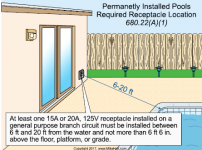Our equipment pad is moving about 20' from where it had previously been and I'm replacing an old load center in the process. Previously there was a separately run 50a line from the main breaker for our heat pump, but all the original wiring (and heat pump line) were torn out during a renovation of the house.
The equipment will be:
- Pentair SuperFlo VS 1.5hp pump (13.6a max draw)
- Pentair Amerilite 500w watt 120v light (~4.2a, though this is very rarely ever used)
- CircuPool SJ30 SWG (.63a at 240v)
- AquaCal TropiCal T135 Heat Pump (43.3 Minimum Circuit Ampacity)
- Two 120v utility outlets (one at pad and one at light j-box)
I'm not planning an automation-capable panel, just a basic outdoor load center. Also, I haven't yet figured out what to do about freeze protection, so that may add a bit of draw. (I've had a separate old Freeze Defender hooked up that worked fine, but it's pretty rusty and I'm having trouble finding any similar standalone product now. Mostly seems like people either have pumps with temp sensors built in or have a timer with it, but I'm not planning a timer since I'll be using the VS pump to schedule things.)
The house's new main outdoor box has an empty 1.5" conduit running to the new pad location and 4 empty breaker slots in it.
If I run a single breaker and line to the sub-panel, I'm thinking I'd need something like an 80a breaker and 4/3 copper? But 4 gauge doesn't seem to be readily available.
Would I be better off running two separate smaller lines through the same conduit? Like a 50a breaker on 6/3 direct to the heat pump and a separate 8/3 line on a 40a breaker for everything else, with separate breakers at the load center (20a for Superflo, 15a for light/j-box outlet, 15a for pad utility outlet)?
The pad is within sight/distance requirements from the main box breaker to not need a separate cutoff at the pad, at least as I understand them.
I don't want to undersize things, but I also don't want to pay out the nose for larger wire than needed. It'll be about a 35' run.
Appreciate any thoughts or guidance. Thanks!
The equipment will be:
- Pentair SuperFlo VS 1.5hp pump (13.6a max draw)
- Pentair Amerilite 500w watt 120v light (~4.2a, though this is very rarely ever used)
- CircuPool SJ30 SWG (.63a at 240v)
- AquaCal TropiCal T135 Heat Pump (43.3 Minimum Circuit Ampacity)
- Two 120v utility outlets (one at pad and one at light j-box)
I'm not planning an automation-capable panel, just a basic outdoor load center. Also, I haven't yet figured out what to do about freeze protection, so that may add a bit of draw. (I've had a separate old Freeze Defender hooked up that worked fine, but it's pretty rusty and I'm having trouble finding any similar standalone product now. Mostly seems like people either have pumps with temp sensors built in or have a timer with it, but I'm not planning a timer since I'll be using the VS pump to schedule things.)
The house's new main outdoor box has an empty 1.5" conduit running to the new pad location and 4 empty breaker slots in it.
If I run a single breaker and line to the sub-panel, I'm thinking I'd need something like an 80a breaker and 4/3 copper? But 4 gauge doesn't seem to be readily available.
Would I be better off running two separate smaller lines through the same conduit? Like a 50a breaker on 6/3 direct to the heat pump and a separate 8/3 line on a 40a breaker for everything else, with separate breakers at the load center (20a for Superflo, 15a for light/j-box outlet, 15a for pad utility outlet)?
The pad is within sight/distance requirements from the main box breaker to not need a separate cutoff at the pad, at least as I understand them.
I don't want to undersize things, but I also don't want to pay out the nose for larger wire than needed. It'll be about a 35' run.
Appreciate any thoughts or guidance. Thanks!
Last edited:


